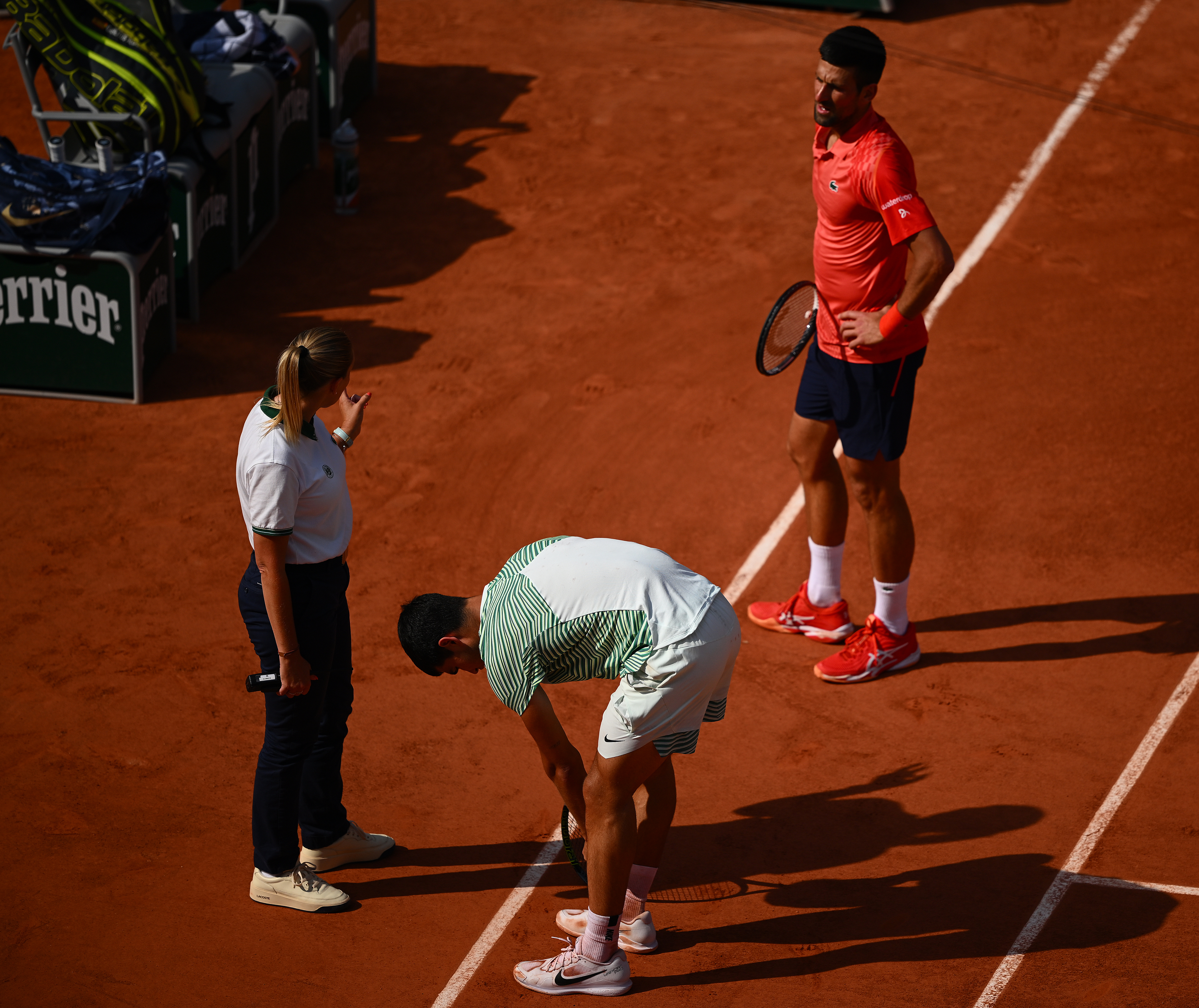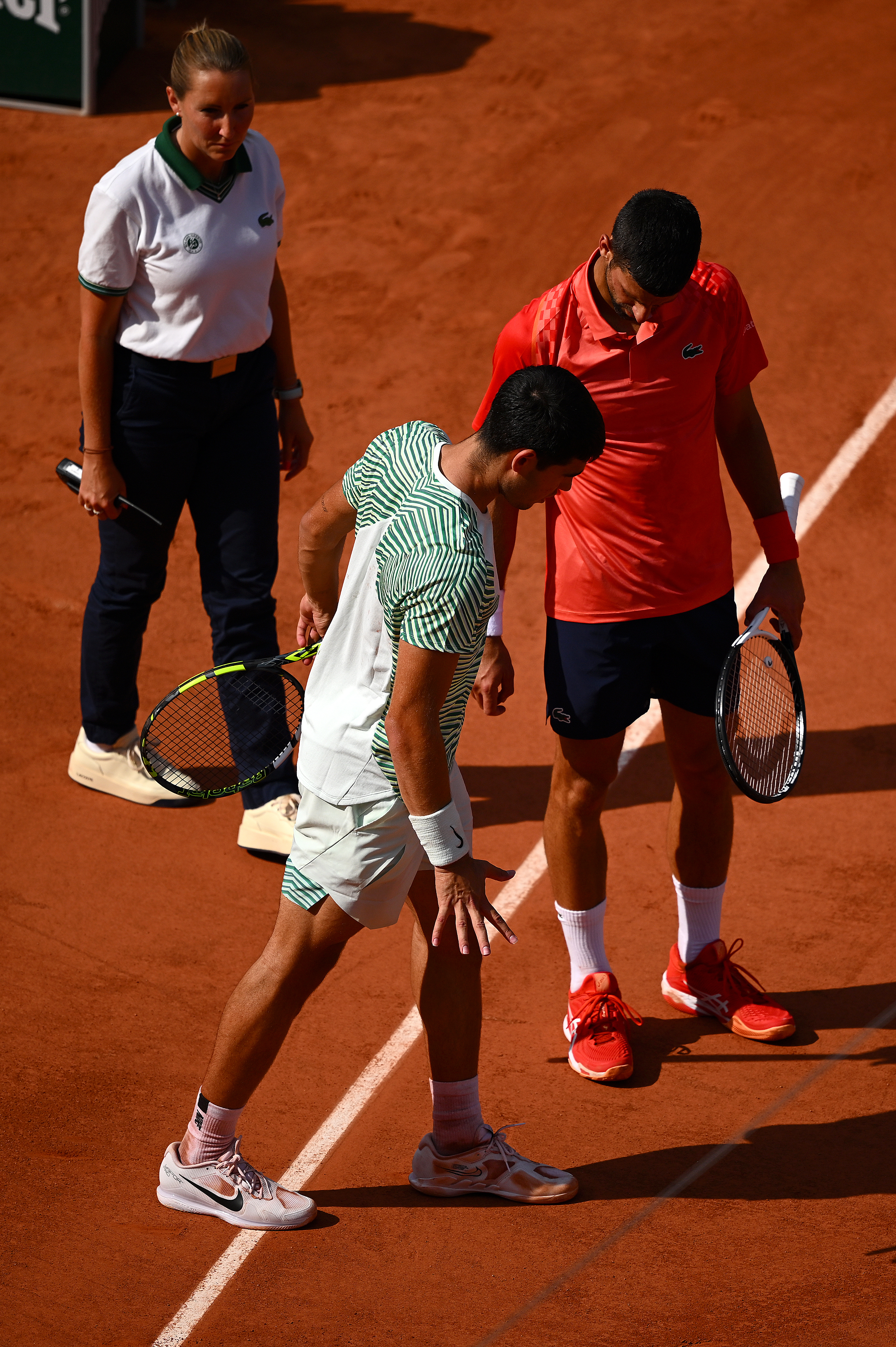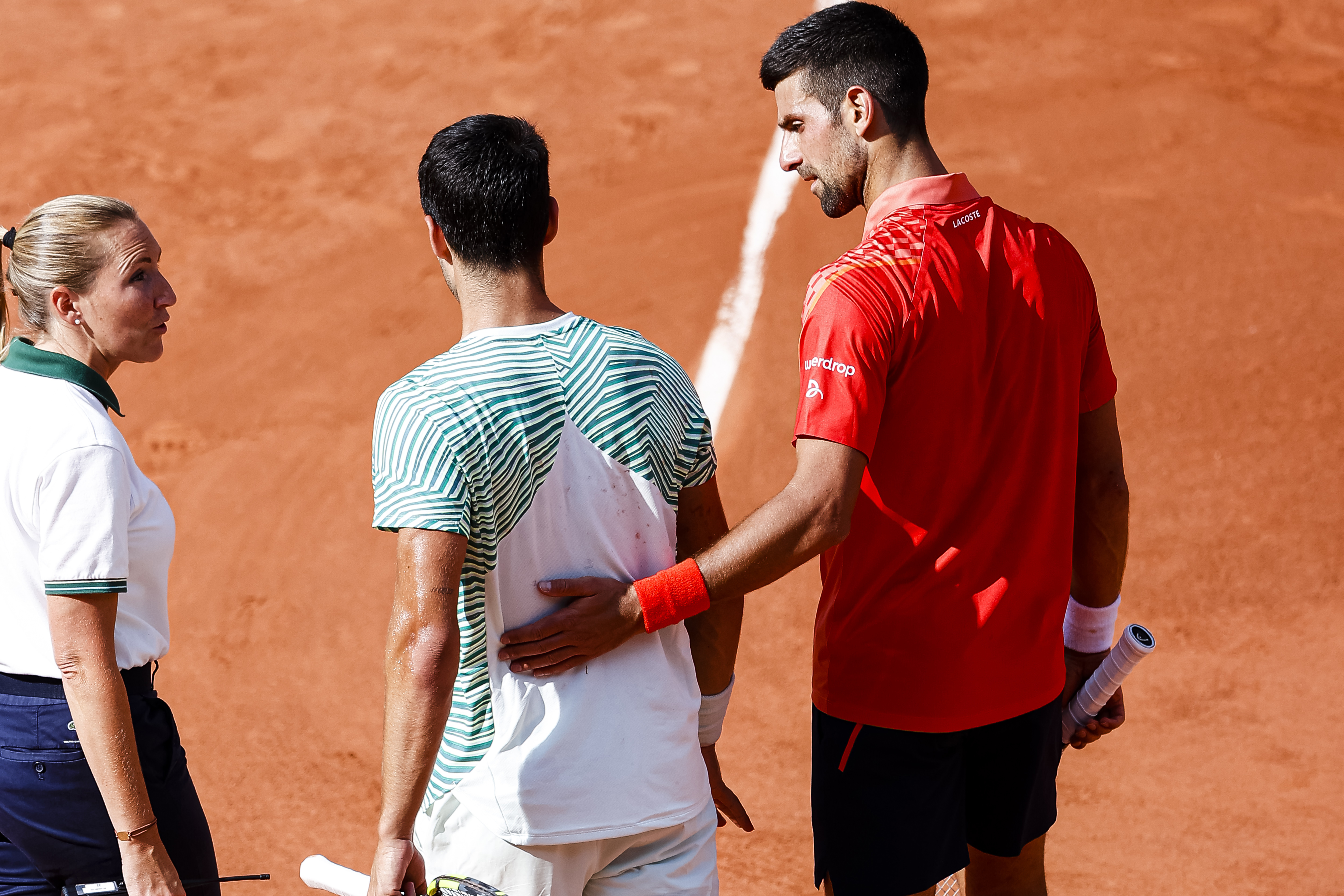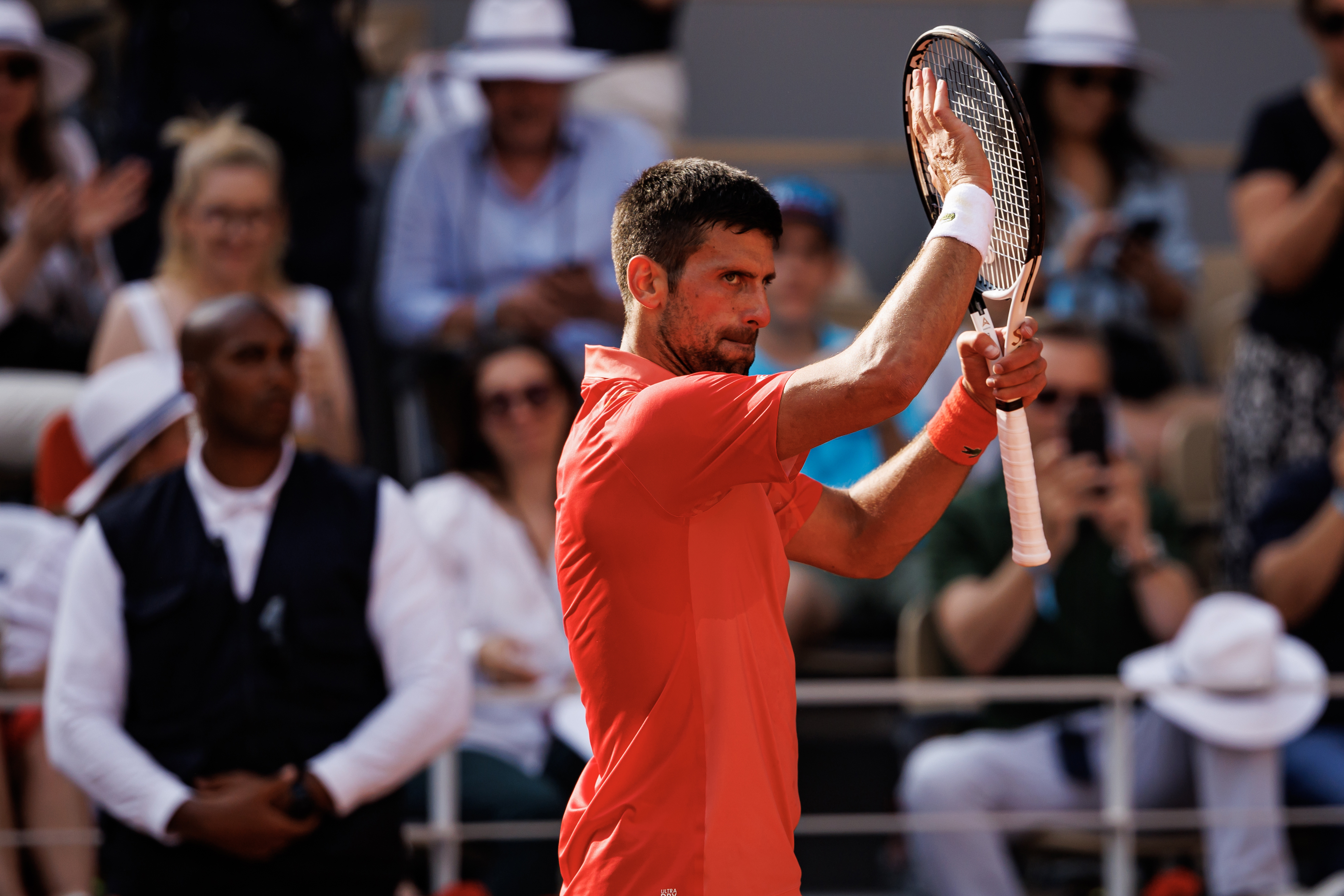
It was Carlos Alcaraz, not Novak Djokovic, who conjured up the “How did he do that?!” shot in the semi-finals that went viral in minutes and will be talked about for years.
It was Alcaraz, 20, not Djokovic, 36, who had youth on his side, of course, the widest gap between Grand Slam semi-finalists since 1991. It was Alcaraz, not Djokovic, who complained to his coach in the early going on Court Philippe Chatrier that the points weren't long enough to wear down his opponent.
Watch Roland-Garros 2023 live and free on 9now.
And yet it was Alcaraz, not Djokovic, who succumbed to the heat and the intensity and, by his own admission, the nerves of the occasion. It was Alcaraz, not Djokovic, whose body broke down. And so it is the No. 3 seed Djokovic, not No. 1 Alcaraz, who will play on in Paris with a chance to add to his trophy collection.
Using every bit of his superiority in experience and fitness, Djokovic beat a cramping Alcaraz 6-3, 5-7, 6-1, 6-1 to reach his 34th major final. That allowed Djokovic to move closer to a 23rd Grand Slam championship, which would break a tie with rival Rafael Nadal for the men's record.

“I can understand the emotions and circumstances that affect you mentally and emotionally. ... Maybe for the first time in his career, he was expected to win,” Djokovic said. “It's a part of the learning curve.”
Score one for the old guys.
“I've never felt the tension that I did in that match,” said Alcaraz, who said the stress he sensed because of the stakes, and the daunting foe across the net, caused cramps in “every part of my body.”
READ MORE: Blows keep coming for NSW as Walker injury confirmed
READ MORE: Freddy rips Maroons star's call after Koroisau hit
READ MORE: Smith's ridiculous record at English Test venue
“He has been in that situation multiple times,” Alcaraz said. “More than me.”
On Sunday, Djokovic will meet No. 4 Casper Ruud, who eliminated No. 22 Alexander Zverev 6-3, 6-4, 6-0.
Ruud will be playing in his third final at the past five majors — including in Paris a year ago, when he lost to Nadal — but is still seeking his first such trophy.
“I tired to play without too many feelings,” Ruud said, “without too much pressure.”

Nadal was absent from his favorite tournament this year because of a hip injury; he had arthroscopic surgery last week.
That left most people focusing on two men: Djokovic, who has won 10 of the past 19 majors, and Alcaraz, who won the U.S. Open in September. Djokovic is one of the dominant figures in the sport’s history; Alcaraz is considered its future.
They sure put on a show for two exhilarating, exhausting sets, with fans breaking into chants of both men's nicknames: “No-le!” and “Car-li-tos!”
“We went toe-to-toe,” Djokovic said.
Watch Roland-Garros 2023 from May 28. Every match ad free and on demand. Centre court coverage in 4K UHD on Stan Sport
He was at his stretching, sliding best, whipping groundstrokes that pushed Alcaraz all over the place. Alcaraz, somehow, chased just about everything down, his speed and instinct as good as there is.
“I told him that he’s got plenty of time, and that I’m sure he’s going to win Roland Garros multiple times in the future. I have no doubt about it,” Djokovic said of their conversation when the match was over. “I mean, he’s an amazing player. Just possesses so much qualities. So dynamic. So much power in his shots. Very complete player.”
Nothing was as memorable as THAT shot by Alcaraz. It was the shot of the day, of the tournament, of the year, reminiscent of one conjured up by Roger Federer on the same court years ago.

It arrived at 1-all in the second set. Having lured Alcaraz forward, Djokovic sent the ball toward the baseline. Many a player would have given up on the point and chosen to move onto the next. Or perhaps attempted to get there but failed. Alcaraz gave chase, running with his back to the net, then sliding beyond the baseline, his left foot bending as he came to a halt and spun his body around, leaning backward in order to lace a forehand past Djokovic for a winner.
As the crowd roared and rose for an ovation to celebrate the feat, Alcaraz raised his left hand and briefly jutted his index finger into the “No. 1” gesture.
He smiled a wide smile.
Even Djokovic had to smile, and used his racket to applaud.
But soon, this highly anticipated match up devolved into something as anticlimactic as can be.
Early in the third set, after nearly 2 1/2 hours of exertion and tension, Alcaraz’s body began to lock up. First, his hand cramped. Then his legs. After missing a forehand return to make the score 1-all, Alcaraz hopped on his left leg, then clutched his right calf. He dropped his racket. Chair umpire Aurélie Tourte went over to check on him. So did Djokovic, walking all the way over to Alcaraz’s side of the court.

A medical timeout for an injury — what the rulebook calls “an acute medical condition” — during a match is allowed. But treatment for cramps when it isn’t a changeover is not permitted without penalty. So Tourte told Alcaraz that he could sit on the sideline and get help from a trainer, but he would need to concede the following game, which he did.
When play resumed with Djokovic ahead 2-1 in that set, the crowd jeered and whistled, until Tourte explained in French what was happening.
“From that moment onwards,” Djokovic said, “it was a different match.”
Alcaraz would only claim one more game.
“It was obvious that he was struggling with his movement. It’s unfortunate for the crowd. It’s unfortunate for the match of this importance for both of us," Djokovic said. “But that’s sport.”
At his news conference, Djokovic was asked about some of the booing that perhaps was directed his way — and what his reaction was.
“I don’t mind. It’s not the first; probably not the last,” he said. “I’ll just keep winning.”
For a daily dose of the best of the breaking news and exclusive content from Wide World of Sports, subscribe to our newsletter by clicking here!
It was Carlos Alcaraz, not Novak Djokovic, who conjured up the “How did he do that?!” shot in the semi-finals that went viral in minutes and will be talked about for years.
It was Alcaraz, 20, not Djokovic, 36, who had youth on his side, of course, the widest gap between Grand Slam semi-finalists since 1991. It was Alcaraz, not Djokovic, who complained to his coach in the early going on Court Philippe Chatrier that the points weren't long enough to wear down his opponent.
Watch Roland-Garros 2023 live and free on 9now.
And yet it was Alcaraz, not Djokovic, who succumbed to the heat and the intensity and, by his own admission, the nerves of the occasion. It was Alcaraz, not Djokovic, whose body broke down. And so it is the No. 3 seed Djokovic, not No. 1 Alcaraz, who will play on in Paris with a chance to add to his trophy collection.
Using every bit of his superiority in experience and fitness, Djokovic beat a cramping Alcaraz 6-3, 5-7, 6-1, 6-1 to reach his 34th major final. That allowed Djokovic to move closer to a 23rd Grand Slam championship, which would break a tie with rival Rafael Nadal for the men's record.

“I can understand the emotions and circumstances that affect you mentally and emotionally. ... Maybe for the first time in his career, he was expected to win,” Djokovic said. “It's a part of the learning curve.”
Score one for the old guys.
“I've never felt the tension that I did in that match,” said Alcaraz, who said the stress he sensed because of the stakes, and the daunting foe across the net, caused cramps in “every part of my body.”
READ MORE: Blows keep coming for NSW as Walker injury confirmed
READ MORE: Freddy rips Maroons star's call after Koroisau hit
READ MORE: Smith's ridiculous record at English Test venue
“He has been in that situation multiple times,” Alcaraz said. “More than me.”
On Sunday, Djokovic will meet No. 4 Casper Ruud, who eliminated No. 22 Alexander Zverev 6-3, 6-4, 6-0.
Ruud will be playing in his third final at the past five majors — including in Paris a year ago, when he lost to Nadal — but is still seeking his first such trophy.
“I tired to play without too many feelings,” Ruud said, “without too much pressure.”

Nadal was absent from his favorite tournament this year because of a hip injury; he had arthroscopic surgery last week.
That left most people focusing on two men: Djokovic, who has won 10 of the past 19 majors, and Alcaraz, who won the U.S. Open in September. Djokovic is one of the dominant figures in the sport’s history; Alcaraz is considered its future.
They sure put on a show for two exhilarating, exhausting sets, with fans breaking into chants of both men's nicknames: “No-le!” and “Car-li-tos!”
“We went toe-to-toe,” Djokovic said.
Watch Roland-Garros 2023 from May 28. Every match ad free and on demand. Centre court coverage in 4K UHD on Stan Sport
He was at his stretching, sliding best, whipping groundstrokes that pushed Alcaraz all over the place. Alcaraz, somehow, chased just about everything down, his speed and instinct as good as there is.
“I told him that he’s got plenty of time, and that I’m sure he’s going to win Roland Garros multiple times in the future. I have no doubt about it,” Djokovic said of their conversation when the match was over. “I mean, he’s an amazing player. Just possesses so much qualities. So dynamic. So much power in his shots. Very complete player.”
Nothing was as memorable as THAT shot by Alcaraz. It was the shot of the day, of the tournament, of the year, reminiscent of one conjured up by Roger Federer on the same court years ago.

It arrived at 1-all in the second set. Having lured Alcaraz forward, Djokovic sent the ball toward the baseline. Many a player would have given up on the point and chosen to move onto the next. Or perhaps attempted to get there but failed. Alcaraz gave chase, running with his back to the net, then sliding beyond the baseline, his left foot bending as he came to a halt and spun his body around, leaning backward in order to lace a forehand past Djokovic for a winner.
As the crowd roared and rose for an ovation to celebrate the feat, Alcaraz raised his left hand and briefly jutted his index finger into the “No. 1” gesture.
He smiled a wide smile.
Even Djokovic had to smile, and used his racket to applaud.
But soon, this highly anticipated match up devolved into something as anticlimactic as can be.
Early in the third set, after nearly 2 1/2 hours of exertion and tension, Alcaraz’s body began to lock up. First, his hand cramped. Then his legs. After missing a forehand return to make the score 1-all, Alcaraz hopped on his left leg, then clutched his right calf. He dropped his racket. Chair umpire Aurélie Tourte went over to check on him. So did Djokovic, walking all the way over to Alcaraz’s side of the court.

A medical timeout for an injury — what the rulebook calls “an acute medical condition” — during a match is allowed. But treatment for cramps when it isn’t a changeover is not permitted without penalty. So Tourte told Alcaraz that he could sit on the sideline and get help from a trainer, but he would need to concede the following game, which he did.
When play resumed with Djokovic ahead 2-1 in that set, the crowd jeered and whistled, until Tourte explained in French what was happening.
“From that moment onwards,” Djokovic said, “it was a different match.”
Alcaraz would only claim one more game.
“It was obvious that he was struggling with his movement. It’s unfortunate for the crowd. It’s unfortunate for the match of this importance for both of us," Djokovic said. “But that’s sport.”
At his news conference, Djokovic was asked about some of the booing that perhaps was directed his way — and what his reaction was.
“I don’t mind. It’s not the first; probably not the last,” he said. “I’ll just keep winning.”
For a daily dose of the best of the breaking news and exclusive content from Wide World of Sports, subscribe to our newsletter by clicking here!
https://ift.tt/5RumjW3//

No comments:
Post a Comment